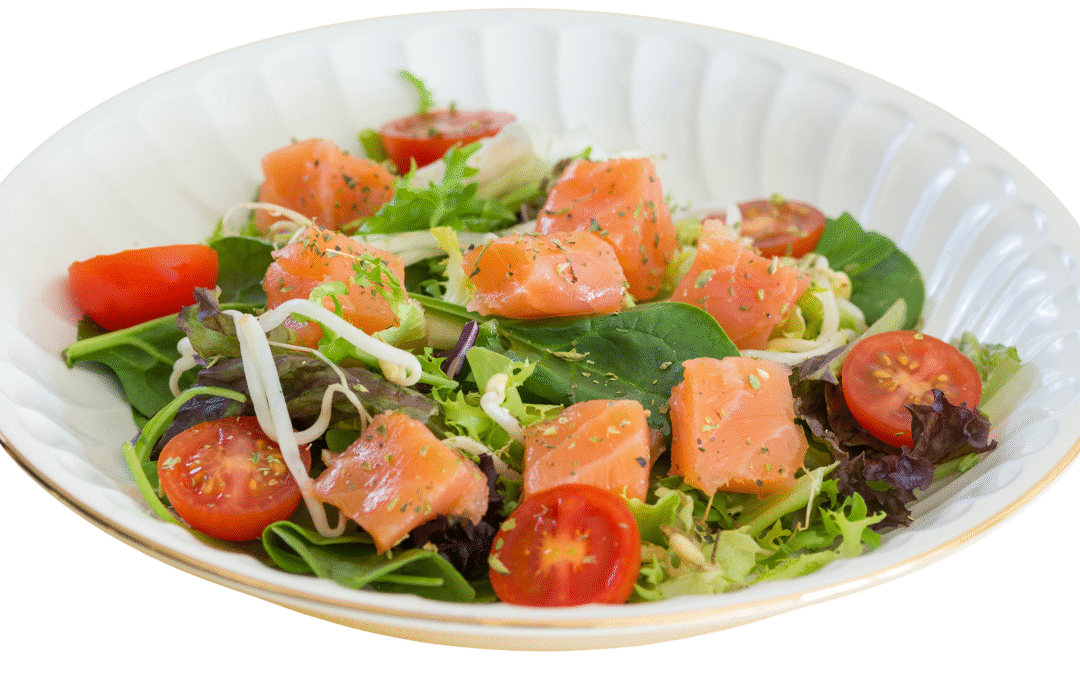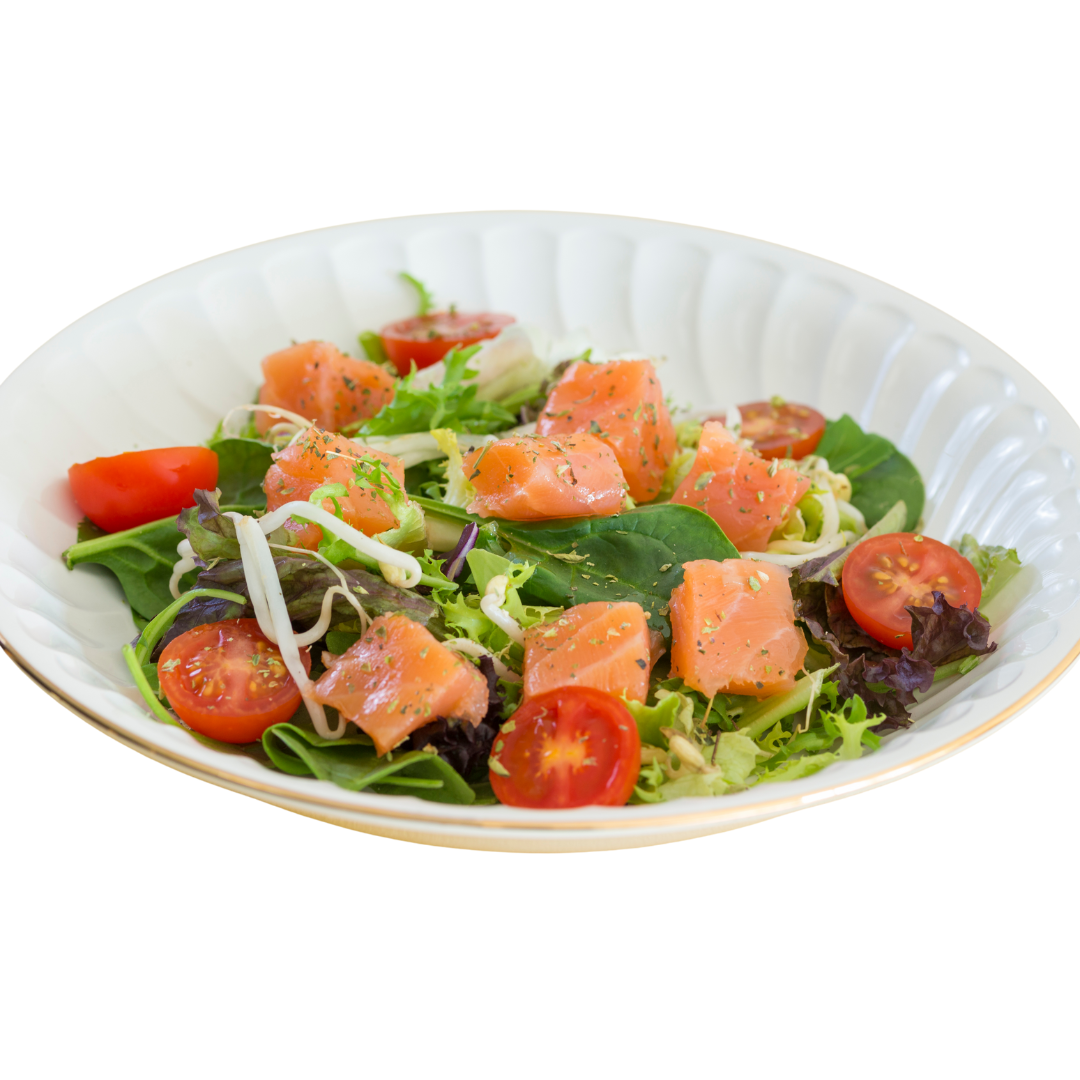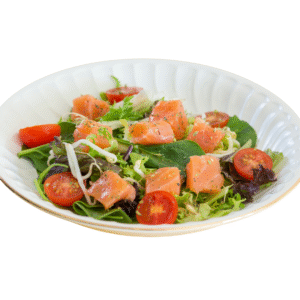
Lemon Garlic Salmon Salad

Quick and easy to prepare, and so delicious, this Salmon Salad incorporates whole foods packed with nutrients. Among the most well-researched and recommended are salmon, spinach, garlic, and tomatoes.
Each ingredient offers unique health-promoting compounds, and together, they form a powerful synergy for disease prevention and vitality.
Salmon
Rich in omega-3 fatty acids, high-quality protein, and vitamin D, salmon supports heart and brain health. A study published in the American Journal of Clinical Nutrition found that regular fish consumption, especially fatty fish like salmon, significantly reduces the risk of cardiovascular disease (Mozaffarian et al., 2005). Omega-3s are also linked to reduced inflammation to help with pain and mood and improved cognitive function.
Spinach
This leafy green is packed with iron, folate, magnesium, and vitamins A, C, and K. Spinach is especially rich in lutein and zeaxanthin, antioxidants known to support eye health. A 2016 study in Nutrients linked higher lutein intake to a reduced risk of age-related macular degeneration (Johnson, 2016). Spinach also contains nitrates, which may help regulate blood pressure.
Garlic
Garlic contains allicin, a sulfur compound known for its medicinal properties. A meta-analysis published in the Journal of Nutrition (Ried et al., 2013) found that garlic supplementation can significantly reduce blood pressure in hypertensive individuals. Garlic also exhibits antimicrobial and immune-boosting properties, making it a natural ally against infections.
Tomatoes
Tomatoes are a rich source of lycopene, a powerful antioxidant that has been linked to reduced risk of several cancers, particularly prostate cancer. A review in Molecular Nutrition & Food Research (Story et al., 2010) highlights how lycopene from tomatoes helps combat oxidative stress and inflammation. Cooked tomatoes are especially effective as heat increases lycopene bioavailability.
Extra Bonus
Spinach, salmon, and walnuts can all help to increase GABA, a chemical in the brain that can help regulate our nervous system to help us reduce feelings of stress, anger, anxiety, frustration, poor sleep and cravings for sugar.
References:
- Mozaffarian, D., & Rimm, E. B. (2006). Fish intake, contaminants, and human health. JAMA, 296(15), 1885–1899.
- Ros, E. et al. (2018). Effect of walnut consumption on lipoprotein subclasses and cholesterol efflux capacity in humans: a randomized controlled trial. JAHA, 7(12), e008819.
- Johnson, E. J. (2016). Role of lutein and zeaxanthin in visual and cognitive function throughout the lifespan. Nutrients, 8(9), 605.
- Ried, K., et al. (2013). Effect of garlic on blood pressure: A systematic review and meta-analysis. The Journal of Nutrition, 143(6), 800–808.
- Story, E. N., et al. (2010). An update on the health effects of tomato lycopene. Molecular Nutrition & Food Research, 54(5), 567–580.

Lemon Garlic Salmon Salad
Ingredients
- 10 oz Salmon Filet
- 1 Lemon (juiced)
- 1 Garlic (clove, large, minced)
- Sea Salt & Black Pepper
- 3 tbsp Butter (cold)
- 4 cups Baby Spinach
- 1 cup Cherry Tomatoes (halved)
- 1/4 Cucumber (medium, sliced)
- 2 tbsp Walnuts - optional (chopped)
Instructions
- Preheat the oven to 375ºF (190ºC). Line a baking dish with parchment paper. Place the salmon in the dish.
- Mix the lemon juice, garlic, salt, and pepper together and pour it over the salmon. Place the butter on top of the salmon and bake for 15 minutes or until the salmon is cooked through.
- Divide the baby spinach evenly between plates. Top with the tomatoes, walnuts, and cucumbers. Divide the salmon between the salads and pour the residual juices all over the salmon and salad. Enjoy!





